Daniel Sanz-Alonso
Functional Multi-Reference Alignment via Deconvolution
Jun 13, 2025Abstract:This paper studies the multi-reference alignment (MRA) problem of estimating a signal function from shifted, noisy observations. Our functional formulation reveals a new connection between MRA and deconvolution: the signal can be estimated from second-order statistics via Kotlarski's formula, an important identification result in deconvolution with replicated measurements. To design our MRA algorithms, we extend Kotlarski's formula to general dimension and study the estimation of signals with vanishing Fourier transform, thus also contributing to the deconvolution literature. We validate our deconvolution approach to MRA through both theory and numerical experiments.
Long-time accuracy of ensemble Kalman filters for chaotic and machine-learned dynamical systems
Dec 18, 2024



Abstract:Filtering is concerned with online estimation of the state of a dynamical system from partial and noisy observations. In applications where the state is high dimensional, ensemble Kalman filters are often the method of choice. This paper establishes long-time accuracy of ensemble Kalman filters. We introduce conditions on the dynamics and the observations under which the estimation error remains small in the long-time horizon. Our theory covers a wide class of partially-observed chaotic dynamical systems, which includes the Navier-Stokes equations and Lorenz models. In addition, we prove long-time accuracy of ensemble Kalman filters with surrogate dynamics, thus validating the use of machine-learned forecast models in ensemble data assimilation.
Inverse Problems and Data Assimilation: A Machine Learning Approach
Oct 14, 2024Abstract:The aim of these notes is to demonstrate the potential for ideas in machine learning to impact on the fields of inverse problems and data assimilation. The perspective is one that is primarily aimed at researchers from inverse problems and/or data assimilation who wish to see a mathematical presentation of machine learning as it pertains to their fields. As a by-product, we include a succinct mathematical treatment of various topics in machine learning.
Data Assimilation with Machine Learning Surrogate Models: A Case Study with FourCastNet
May 21, 2024Abstract:Modern data-driven surrogate models for weather forecasting provide accurate short-term predictions but inaccurate and nonphysical long-term forecasts. This paper investigates online weather prediction using machine learning surrogates supplemented with partial and noisy observations. We empirically demonstrate and theoretically justify that, despite the long-time instability of the surrogates and the sparsity of the observations, filtering estimates can remain accurate in the long-time horizon. As a case study, we integrate FourCastNet, a state-of-the-art weather surrogate model, within a variational data assimilation framework using partial, noisy ERA5 data. Our results show that filtering estimates remain accurate over a year-long assimilation window and provide effective initial conditions for forecasting tasks, including extreme event prediction.
Bayesian Optimization with Noise-Free Observations: Improved Regret Bounds via Random Exploration
Jan 30, 2024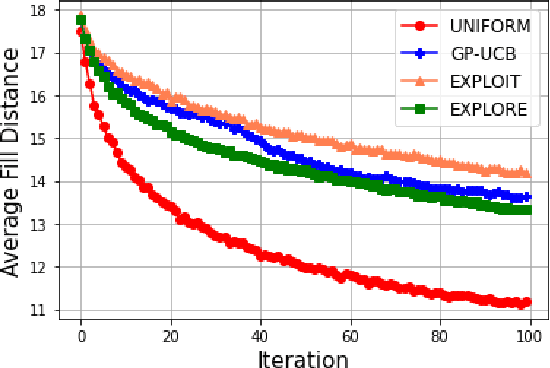

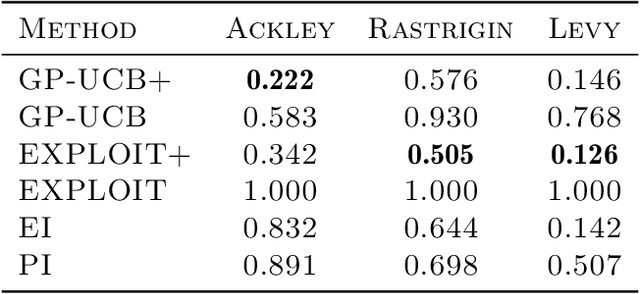
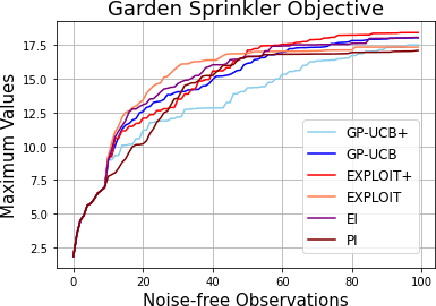
Abstract:This paper studies Bayesian optimization with noise-free observations. We introduce new algorithms rooted in scattered data approximation that rely on a random exploration step to ensure that the fill-distance of query points decays at a near-optimal rate. Our algorithms retain the ease of implementation of the classical GP-UCB algorithm and satisfy cumulative regret bounds that nearly match those conjectured in arXiv:2002.05096, hence solving a COLT open problem. Furthermore, the new algorithms outperform GP-UCB and other popular Bayesian optimization strategies in several examples.
Gaussian Process Regression under Computational and Epistemic Misspecification
Dec 14, 2023Abstract:Gaussian process regression is a classical kernel method for function estimation and data interpolation. In large data applications, computational costs can be reduced using low-rank or sparse approximations of the kernel. This paper investigates the effect of such kernel approximations on the interpolation error. We introduce a unified framework to analyze Gaussian process regression under important classes of computational misspecification: Karhunen-Lo\`eve expansions that result in low-rank kernel approximations, multiscale wavelet expansions that induce sparsity in the covariance matrix, and finite element representations that induce sparsity in the precision matrix. Our theory also accounts for epistemic misspecification in the choice of kernel parameters.
Reduced-Order Autodifferentiable Ensemble Kalman Filters
Jan 27, 2023Abstract:This paper introduces a computational framework to reconstruct and forecast a partially observed state that evolves according to an unknown or expensive-to-simulate dynamical system. Our reduced-order autodifferentiable ensemble Kalman filters (ROAD-EnKFs) learn a latent low-dimensional surrogate model for the dynamics and a decoder that maps from the latent space to the state space. The learned dynamics and decoder are then used within an ensemble Kalman filter to reconstruct and forecast the state. Numerical experiments show that if the state dynamics exhibit a hidden low-dimensional structure, ROAD-EnKFs achieve higher accuracy at lower computational cost compared to existing methods. If such structure is not expressed in the latent state dynamics, ROAD-EnKFs achieve similar accuracy at lower cost, making them a promising approach for surrogate state reconstruction and forecasting.
Non-Asymptotic Analysis of Ensemble Kalman Updates: Effective Dimension and Localization
Aug 05, 2022
Abstract:Many modern algorithms for inverse problems and data assimilation rely on ensemble Kalman updates to blend prior predictions with observed data. Ensemble Kalman methods often perform well with a small ensemble size, which is essential in applications where generating each particle is costly. This paper develops a non-asymptotic analysis of ensemble Kalman updates that rigorously explains why a small ensemble size suffices if the prior covariance has moderate effective dimension due to fast spectrum decay or approximate sparsity. We present our theory in a unified framework, comparing several implementations of ensemble Kalman updates that use perturbed observations, square root filtering, and localization. As part of our analysis, we develop new dimension-free covariance estimation bounds for approximately sparse matrices that may be of independent interest.
Mathematical Foundations of Graph-Based Bayesian Semi-Supervised Learning
Jul 03, 2022

Abstract:In recent decades, science and engineering have been revolutionized by a momentous growth in the amount of available data. However, despite the unprecedented ease with which data are now collected and stored, labeling data by supplementing each feature with an informative tag remains to be challenging. Illustrative tasks where the labeling process requires expert knowledge or is tedious and time-consuming include labeling X-rays with a diagnosis, protein sequences with a protein type, texts by their topic, tweets by their sentiment, or videos by their genre. In these and numerous other examples, only a few features may be manually labeled due to cost and time constraints. How can we best propagate label information from a small number of expensive labeled features to a vast number of unlabeled ones? This is the question addressed by semi-supervised learning (SSL). This article overviews recent foundational developments on graph-based Bayesian SSL, a probabilistic framework for label propagation using similarities between features. SSL is an active research area and a thorough review of the extant literature is beyond the scope of this article. Our focus will be on topics drawn from our own research that illustrate the wide range of mathematical tools and ideas that underlie the rigorous study of the statistical accuracy and computational efficiency of graph-based Bayesian SSL.
A Variational Inference Approach to Inverse Problems with Gamma Hyperpriors
Nov 29, 2021

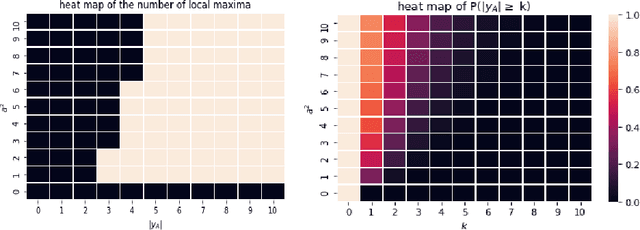
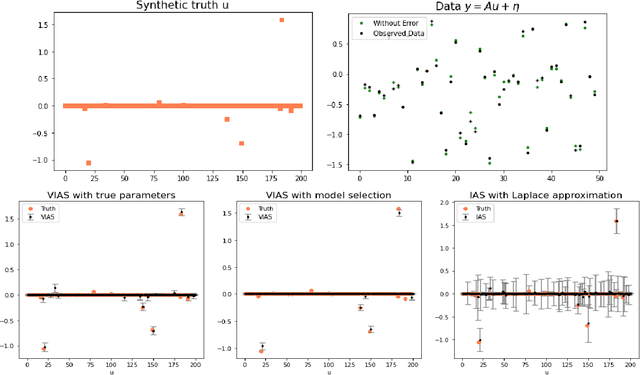
Abstract:Hierarchical models with gamma hyperpriors provide a flexible, sparse-promoting framework to bridge $L^1$ and $L^2$ regularizations in Bayesian formulations to inverse problems. Despite the Bayesian motivation for these models, existing methodologies are limited to \textit{maximum a posteriori} estimation. The potential to perform uncertainty quantification has not yet been realized. This paper introduces a variational iterative alternating scheme for hierarchical inverse problems with gamma hyperpriors. The proposed variational inference approach yields accurate reconstruction, provides meaningful uncertainty quantification, and is easy to implement. In addition, it lends itself naturally to conduct model selection for the choice of hyperparameters. We illustrate the performance of our methodology in several computed examples, including a deconvolution problem and sparse identification of dynamical systems from time series data.
 Add to Chrome
Add to Chrome Add to Firefox
Add to Firefox Add to Edge
Add to Edge